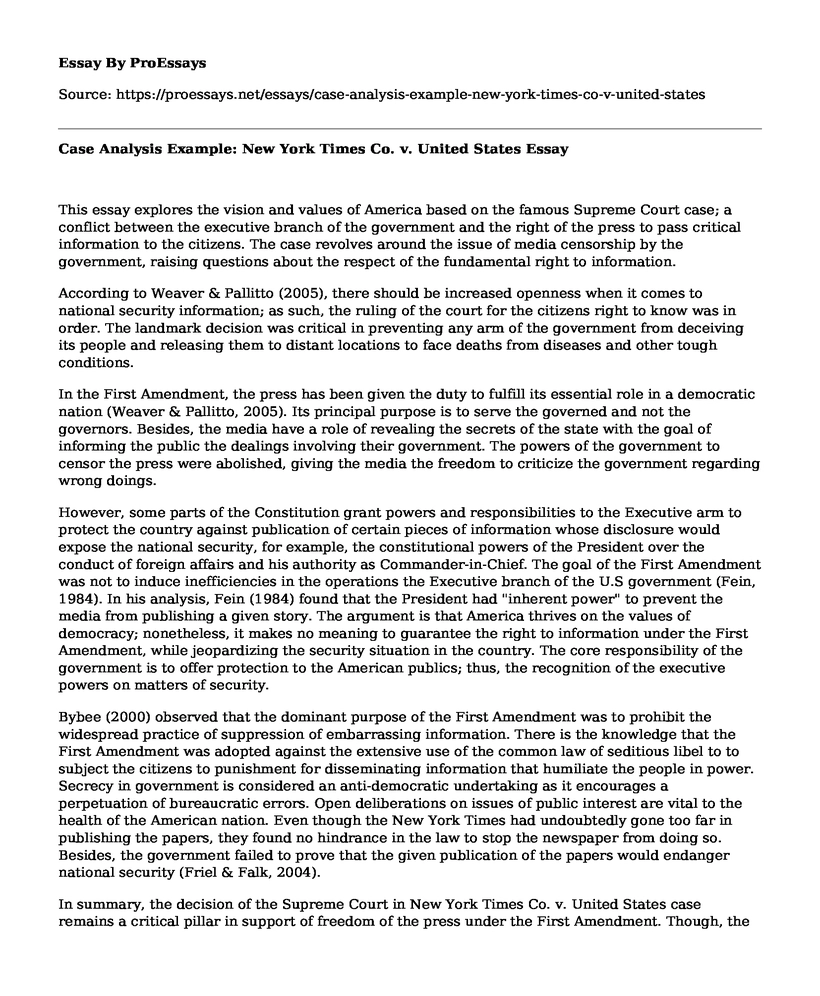This essay explores the vision and values of America based on the famous Supreme Court case; a conflict between the executive branch of the government and the right of the press to pass critical information to the citizens. The case revolves around the issue of media censorship by the government, raising questions about the respect of the fundamental right to information.
According to Weaver & Pallitto (2005), there should be increased openness when it comes to national security information; as such, the ruling of the court for the citizens right to know was in order. The landmark decision was critical in preventing any arm of the government from deceiving its people and releasing them to distant locations to face deaths from diseases and other tough conditions.
In the First Amendment, the press has been given the duty to fulfill its essential role in a democratic nation (Weaver & Pallitto, 2005). Its principal purpose is to serve the governed and not the governors. Besides, the media have a role of revealing the secrets of the state with the goal of informing the public the dealings involving their government. The powers of the government to censor the press were abolished, giving the media the freedom to criticize the government regarding wrong doings.
However, some parts of the Constitution grant powers and responsibilities to the Executive arm to protect the country against publication of certain pieces of information whose disclosure would expose the national security, for example, the constitutional powers of the President over the conduct of foreign affairs and his authority as Commander-in-Chief. The goal of the First Amendment was not to induce inefficiencies in the operations the Executive branch of the U.S government (Fein, 1984). In his analysis, Fein (1984) found that the President had "inherent power" to prevent the media from publishing a given story. The argument is that America thrives on the values of democracy; nonetheless, it makes no meaning to guarantee the right to information under the First Amendment, while jeopardizing the security situation in the country. The core responsibility of the government is to offer protection to the American publics; thus, the recognition of the executive powers on matters of security.
Bybee (2000) observed that the dominant purpose of the First Amendment was to prohibit the widespread practice of suppression of embarrassing information. There is the knowledge that the First Amendment was adopted against the extensive use of the common law of seditious libel to to subject the citizens to punishment for disseminating information that humiliate the people in power. Secrecy in government is considered an anti-democratic undertaking as it encourages a perpetuation of bureaucratic errors. Open deliberations on issues of public interest are vital to the health of the American nation. Even though the New York Times had undoubtedly gone too far in publishing the papers, they found no hindrance in the law to stop the newspaper from doing so. Besides, the government failed to prove that the given publication of the papers would endanger national security (Friel & Falk, 2004).
In summary, the decision of the Supreme Court in New York Times Co. v. United States case remains a critical pillar in support of freedom of the press under the First Amendment. Though, the publication of the Pentagon Papers should have been enjoined until the courts had adequate to do a careful evaluation of the legal issues and the impact of the release of the documents on the interests of the state.
References
Bybee, J. S. (2000). Common Ground: Robert Jackson, Antonin Scalia, and a Power Theory of the First Amendment. Tul. L. Rev., 75(2), 251-336.
Fein, B. E. (1984). Access to classified information: Constitutional and statutory dimensions. Wm. & Mary L. Rev., 26(5), 805-844.
Friel, H., & Falk, R. A. (2004). The record of the paper: How the New York Times misreports US foreign policy. New York, NY: Verso.
Weaver, W. G., & Pallitto, R. M. (2005). State secrets and executive power. Political Science Quarterly, 120(1), 85-112.
Cite this page
Case Analysis Example: New York Times Co. v. United States. (2021, Mar 25). Retrieved from https://proessays.net/essays/case-analysis-example-new-york-times-co-v-united-states
If you are the original author of this essay and no longer wish to have it published on the ProEssays website, please click below to request its removal:
- Ethical Theory: Ethical Egoism Essay Example
- Philosophical Considerations on the Future of Artificial Intelligence Essay
- Essay Sample on Achieving the American Dream: Challenges and Opportunities
- Leadership Beyond the Physical: A Review of Spiritual Leadership - Essay Sample
- Essay Example on Propaganda: Intentional Distortion of Information for Desired Effects
- Essay Example on Living Ethically: A Paradox of Human Rights & Nature
- Essay Example on Corporate Social Responsibility: Enhancing Brand Value & Improving Society







